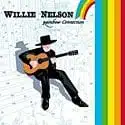
Over the course of a long and winding career, Willie Nelson has been a lot of things: gifted songwriter, outlaw country singer, concept album master, and even a Latin-country genre-buster. But on his latest album, Rainbow Connection, he moves in a totally new direction — childrens’ singer.
That’s right, Rainbow Connection was originally envisioned as a collection of songs for children. In true Willie Nelson fashion, however, the album evolved into much more than that. In the end, Rainbow Connection is a children’s album, a family album (Nelson’s family and friends join him on several songs), a concept album about the journey through life, and maybe just a couple of old favorites Nelson simply felt like singing.
The album begins with the title track and Kermit the Frog favorite, which is perhaps the best of the “children” songs on the album. Also notable are the recess favorite “Playmate” and “Ol’ Blue”, a somber traditional number. Mixed into the first half of the album are several less successful songs, such as the cheesy sing-along “I’m Looking Over a Four-Leaf Clover”. Nelson’s daughter Amy adds some of her own work, including her pretty rendition of “Rock Me to Sleep”. The second half of the album moves away from the children’s theme and into darker territory that will be more familiar to longtime Nelson listeners. The cautionary tale of “Playin’ Dominoes and Shootin’ Dice” and “Wouldn’t Have It Any Other Way”, the latest song written by Nelson, speak to a more mature audience. The album closes with two Mickey Newbury numbers — “Just Dropped In (To See What Condition My Condition Was In)” and “The Thirty-Third of August” — that are among the strongest songs on the album.
Although it’s not intended only for children, it’s interesting to think about Rainbow Connection as a children’s album and Willie Nelson as a children’s singer. The world of children’s albums is overrun with moonbeams-and-fairy dust sentiment and it’s refreshing to hear someone like Nelson show up with a much-needed jolt of reality. Sort of like Fred Rogers’ crazy pot-smoking little brother showing up on a Harley during the middle of a show. Willie’s got a lot of good lessons to teach the next generation (most of them probably learned the hard way) and he mixes darker lyrics in with the sunshine and rainbows. Among the lessons I took away from this album: if you have a dog you love, it will die; if you’re a drinker, gambler, and womanizer, you’ll end up getting shot once or twice; and every now and then you’ll wake up in a squad car “busted down for vagrancy. I recently read an article that claimed many children were growing up too insulated from the disappointments life will inevitably bring. Rainbow Connection might be an appropriate antidote, as the world Nelson relates to children is overwhelmingly real, full of heartbreak and loneliness, but also filled with friendship and beauty.
This is probably Nelson’s most casual and intimate album of recent years. The feel is so off-the-cuff that it’s been described as “half-assed”. Yet Nelson is at his best when he sounds this close. And for his fans, perhaps this album is most successful at illuminating some of the deeper parts of the artist’s personality. In the liner notes, Nelson claims that he made his Grandmother play “Ol’ Blue” for him at her organ every day when he was four. “Ol’ Blue” is about a well-loved dog that “died so hard / that he graveled little holes all over the yard”. I think Nelson tells us much by relating this song, which always made him cry, was one of his favorites.
Indeed, it is the darker songs on the second half of the album that are the standouts, from “Playin’ Dominoes and Shootin’ Dice” to Mickey Newbury’s lonely “The Thirty-Third of August”. In the end, Rainbow Connection reaffirms what we already knew about Willie Nelson: he is an artist who refuses to be categorized, singing whatever songs seem appropriate with his own special sincerity. And his stark and lonely voice is at its best when he’s exploring the deep and dark parts of the human condition.
